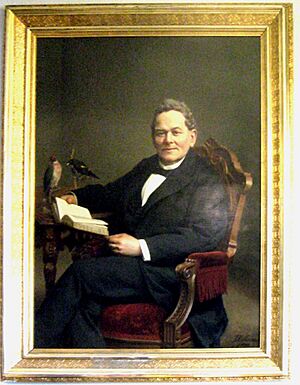Hermann Schlegel facts for kids
Quick facts for kids
Hermann Schlegel
|
|
|---|---|
 |
|
| Born | 10 June 1804 |
| Died | 17 January 1884 (aged 79) |
| Nationality | German |
| Scientific career | |
| Fields | Ornithology, Herpetology |
| Institutions | Natural history museum of Leiden |
Hermann Schlegel (born June 10, 1804 – died January 17, 1884) was a famous German scientist. He spent his life studying animals. He was an ornithologist, meaning he studied birds. He was also a herpetologist, studying reptiles like snakes and lizards. Plus, he was an ichthyologist, which means he studied fish.
Contents
Early Life and His Love for Nature
Hermann Schlegel was born in a town called Altenburg. His father worked with brass, but he also loved collecting butterflies. This hobby sparked young Hermann's interest in natural history, which is the study of nature.
One day, Hermann found a buzzard's nest by accident. This exciting discovery made him want to learn all about birds. He even met a famous bird expert named Christian Ludwig Brehm.
Hermann started working for his father. But he soon realized he wanted to do something else. In 1824, he traveled to Vienna, a big city. There, he went to the university and learned from scientists like Leopold Fitzinger and Johann Jacob Heckel. Thanks to a letter from Brehm, he got a job at the Naturhistorisches Museum, a natural history museum.
A Career Studying Animals
Just one year later, the museum director, Carl Franz Anton Ritter von Schreibers, suggested Hermann for a new job. Coenraad Jacob Temminck, who ran the natural history museum in Leiden, needed an assistant. Hermann got the job!
At first, Hermann mostly worked with the museum's collection of reptiles. He even wrote an important book about snakes called Essai sur la Physionomie des Serpens in 1837. Soon, he started studying other animal groups too. There was a plan for Hermann to travel to Java to join a special Natural History Commission. But sadly, Temminck's chosen successor, Heinrich Boie, passed away. So, Hermann couldn't go on that trip.
During this time, Hermann met Philipp Franz von Siebold. They became very good friends. They even worked together on a big book called Fauna Japonica (1845-1850), which was about animals from Japan.
In 1847, Hermann became a correspondent for the Royal Institute of the Netherlands. Later, in 1851, when it became the Royal Netherlands Academy of Arts and Sciences, he became a full member.
Hermann had strong beliefs about species. He thought that species were fixed and didn't change over time. Because of this, he disagreed with Charles Darwin's theory of evolution, which Darwin wrote about in his book On the Origin of Species. Darwin knew about Hermann's views. His friend, the botanist Joseph Dalton Hooker, once said that Schlegel believed in "multiple creation" and was "against migration" of species.
Leading the Natural History Museum
In 1858, Temminck passed away. After working under him for 33 years, Hermann Schlegel became the new director of the natural history museum. Hermann was very interested in animals from Southeast Asia.
In 1857, he sent his own son, Gustav, to China to collect birds. But when Gustav arrived, he found that another collector, Robert Swinhoe, had already been there. In 1859, Hermann sent Heinrich Agathon Bernstein to collect birds in New Guinea. After Bernstein died in 1865, Hermann von Rosenberg took over his work.
Hermann also hired a young assistant named Otto Finsch. At the same time, he started a scientific magazine called Notes from the Leyden Museum. He also began working on a huge, 14-volume book series called Muséum d'histoire naturelle des Pays-Bas (1862-1880). To help with these projects, he hired three very talented artists: John Gerrard Keulemans, Joseph Smit, and Joseph Wolf. They drew amazing pictures of the animals.
The last years of Hermann Schlegel's life were tough. His wife died in 1864. His assistant, Finsch, moved to another museum in Bremen. Also, the collections at the British Museum started to become bigger and more famous than the ones in Leiden.
Hermann Schlegel died on January 17, 1884, in Leiden.
His sons also became famous. Gustaaf Schlegel (1840-1903) was a sinologist (someone who studies China) and a naturalist. Leander Schlegel (1844-1913) was a composer and pianist.
Animals Named After Schlegel
Many animals have been named in honor of Hermann Schlegel. Here are a few:
- Eyelash viper (Bothriechis schlegelii): A type of venomous snake with scales above its eyes that look like eyelashes.
- False gharial (Tomistoma schlegelii): A type of crocodilian that looks like a crocodile but has a very long, thin snout.
- The Giant sharkminnow (Osteochilus schlegelii): A large fish.
- Red-headed reed snake (Calamaria schlegeli): A nonvenomous snake with a reddish head.
- Royal Penguin (Eudyptes schlegeli): A type of crested penguin found in the sub-Antarctic.
- Schlegel's adder (Aspidomorphus schlegelii): A venomous snake from the elapid family.
- Schlegel's beaked blind snake (Afrotyphlops schlegelii): A nonvenomous snake that burrows underground.
- Schlegel's forest skink (Sphenomorphus schlegeli): A type of lizard found in forests.
- Schlegel's green tree frog (Rhacophorus schlegelii): A type of shrub frog, often found in trees.
See also
- Category:Taxa named by Hermann Schlegel

